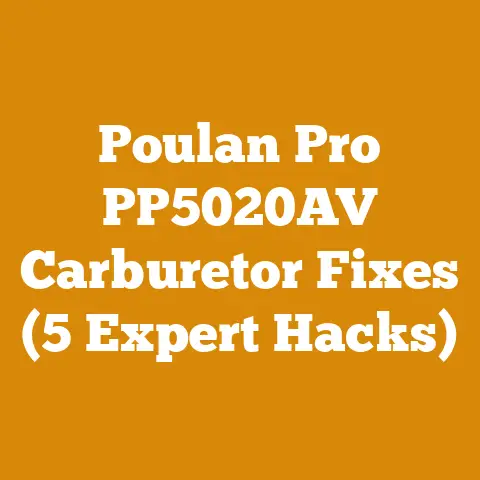550XP Muffler Mod Tips (5 Pro Hacks for Better Chainsaw Performance)
Did you know that modifying your chainsaw’s muffler can boost its power by up to 20%? As someone who’s spent years felling trees and processing firewood, I’ve seen firsthand how a simple muffler mod can transform a Husqvarna 550XP from a reliable tool into a true beast. In this guide, I’ll walk you through five pro hacks to get the most out of your 550XP muffler modification, based on my personal experiences and the collective knowledge of seasoned loggers. Let’s dive in!
550XP Muffler Mod Tips: 5 Pro Hacks for Better Chainsaw Performance
Understanding the Husqvarna 550XP and Its Muffler
Before we get into the nitty-gritty of modifications, let’s understand what we’re working with. The Husqvarna 550XP is a popular professional-grade chainsaw known for its power-to-weight ratio. The muffler’s primary function is to reduce noise and direct exhaust gases away from the operator. However, the stock muffler often restricts exhaust flow, limiting the engine’s potential. A muffler mod aims to alleviate this restriction, allowing the engine to breathe easier and produce more power.
Hack #1: Assessing Your Chainsaw’s Condition
Before even thinking about modifying the muffler, I always make sure my 550XP is in tip-top shape. This means checking the following:
- Air Filter: A clean air filter is crucial. A clogged filter restricts airflow, negating any benefits from the muffler mod. Clean or replace as needed. I typically replace mine every 50 hours of use.
- Spark Plug: A healthy spark plug ensures optimal combustion. Check the spark plug’s condition and replace it if it’s fouled or worn. I prefer NGK plugs and replace them annually, regardless of hours.
- Fuel System: Ensure the fuel lines and fuel filter are clean and free of obstructions. Ethanol-blended fuel can wreak havoc on small engines, so I use premium fuel with a fuel stabilizer.
- Carburetor: The carburetor needs to be properly adjusted to match the increased airflow from the muffler mod. More on this later.
- Compression: Check the compression. A healthy 550XP should have compression around 150-160 PSI. Low compression indicates engine wear, and a muffler mod won’t solve underlying mechanical issues.
Takeaway: A well-maintained chainsaw is the foundation for a successful muffler mod. Don’t skip this step!
Hack #2: Choosing the Right Muffler Modification Method
There are several ways to modify the 550XP muffler, ranging from simple to more complex. Here are three common methods, along with my experience with each:
- Drilling Additional Holes: This is the simplest method. Drill a few additional holes in the muffler’s deflector plate. Start small (1/4 inch) and gradually increase the size until you achieve the desired performance. I’ve used this method on older saws and found it provides a modest improvement.
- Enlarging the Existing Outlet: This involves enlarging the existing exhaust outlet. This can be done with a rotary tool or a file. Be careful not to damage the muffler housing. I’ve had mixed results with this method. It can improve performance, but it also increases noise significantly.
- Adding a Second Outlet: This involves cutting a new outlet in the muffler and welding on a deflector. This is the most involved method but offers the greatest potential for performance gains. I prefer this method for my 550XP because it allows for more precise tuning.
My Preferred Method: Adding a Second Outlet
I find that adding a second outlet offers the best balance of performance and control. Here’s why:
- Increased Exhaust Flow: A second outlet significantly increases exhaust flow, allowing the engine to breathe much easier.
- Tunability: The size and placement of the second outlet can be adjusted to fine-tune the engine’s performance.
- Heat Dissipation: A larger exhaust area helps to dissipate heat more effectively, which can improve engine longevity.
Tool List for Adding a Second Outlet:
- Welder (MIG or TIG)
- Angle Grinder with cutting and grinding discs
- Rotary Tool (Dremel)
- Drill with various sized drill bits
- Metal File
- Measuring Tape
- Safety Glasses
- Welding Helmet
- Welding Gloves
- Metal for the new deflector (I use 16-gauge steel)
Step-by-Step Guide to Adding a Second Outlet:
- Preparation: Disconnect the spark plug wire and remove the muffler from the chainsaw. Clean the muffler thoroughly with a wire brush.
- Marking the Outlet: Decide where you want to place the second outlet. I usually place it on the opposite side of the existing outlet, slightly higher. Mark the area with a marker. I typically make the new outlet about 75% of the size of the original.
- Cutting the Outlet: Use the angle grinder with a cutting disc to carefully cut out the opening for the new outlet. Take your time and make small cuts to avoid damaging the muffler.
- Fabricating the Deflector: Cut a piece of metal to the desired shape for the new deflector. I usually make it slightly larger than the outlet to provide adequate protection. Bend the metal to the desired angle.
- Welding the Deflector: Position the deflector over the new outlet and weld it in place. Use short, controlled welds to avoid overheating the metal. Let the weld cool between passes to prevent warping.
- Grinding and Finishing: Use the angle grinder with a grinding disc to smooth out any rough edges and remove excess weld material. Use the rotary tool to clean up any hard-to-reach areas.
- Painting (Optional): Paint the muffler with high-temperature paint to prevent rust.
Takeaway: Choose the muffler modification method that best suits your skills and tools. Adding a second outlet offers the greatest potential for performance gains, but it requires welding skills.
Hack #3: Carburetor Adjustment is Key
A muffler mod changes the airflow dynamics of your engine. This means you must adjust the carburetor to compensate. Failing to do so can lead to a lean condition, which can damage your engine.
Understanding Carburetor Adjustments:
The 550XP carburetor has three adjustment screws:
- L (Low Speed): Adjusts the fuel mixture at idle and low RPMs.
- H (High Speed): Adjusts the fuel mixture at high RPMs.
- LA (Idle Speed): Adjusts the engine’s idle speed.
The Procedure:
- Warm Up: Start the chainsaw and let it warm up for a few minutes.
- Idle Speed (LA): Adjust the LA screw until the chain is no longer moving at idle.
- Low Speed (L): Turn the L screw in (clockwise) until the engine starts to stumble or die. Then, turn it out (counter-clockwise) until the engine runs smoothly and accelerates cleanly without hesitation. I usually find the sweet spot is about 1/4 turn out from the stumbling point.
- High Speed (H): This is the most critical adjustment. Use a tachometer to monitor the engine’s RPM. With the chainsaw running at full throttle in a cut, slowly turn the H screw out (counter-clockwise) until the engine starts to “four-stroke” (a characteristic burbling sound). Then, turn it in (clockwise) until the four-stroking just disappears. The goal is to get the engine running as lean as possible without damaging it. The maximum RPM for a 550XP is around 13,500 RPM. Keep it slightly below that under load.
- Fine Tuning: After making these adjustments, let the engine cool down and repeat the process to fine-tune the settings.
Important Safety Note: Always wear hearing protection and eye protection when adjusting the carburetor. Be extremely careful when running the chainsaw at full throttle.
Lean vs. Rich:
- Lean: Too little fuel. The engine will run hot, lack power, and can be damaged. Symptoms include high RPMs, difficulty starting, and a “screaming” sound.
- Rich: Too much fuel. The engine will run sluggish, produce excessive smoke, and waste fuel. Symptoms include low RPMs, black smoke, and a “bogging” sound.
My Experience: I once leaned out a 550XP too much after a muffler mod. Within an hour of cutting, the piston seized due to overheating. It was a costly mistake that taught me the importance of precise carburetor adjustment and monitoring engine performance.
Takeaway: Carburetor adjustment is crucial after a muffler mod. Use a tachometer to ensure the engine is running within its safe RPM range. Start rich and gradually lean out the mixture until you find the sweet spot.
Hack #4: Consider a High-Flow Air Filter
While not strictly a muffler mod tip, upgrading to a high-flow air filter can further enhance the performance gains. A high-flow air filter allows even more air into the engine, complementing the increased exhaust flow from the muffler mod.
Benefits of a High-Flow Air Filter:
- Increased Airflow: Allows more air into the engine, resulting in better combustion.
- Improved Throttle Response: The engine responds more quickly to throttle inputs.
- Enhanced Power: Can provide a slight increase in horsepower.
My Recommendation: I’ve had good results with aftermarket air filters designed specifically for the 550XP. Look for filters made from high-quality materials that are easy to clean.
Installation:
Installing a high-flow air filter is straightforward. Simply remove the stock air filter and replace it with the high-flow filter. You may need to re-adjust the carburetor after installing a high-flow air filter.
Takeaway: A high-flow air filter can further enhance the performance gains from a muffler mod by increasing airflow.
Hack #5: Monitor Engine Temperature and Spark Arrestor Considerations
After performing a muffler mod, it’s crucial to monitor the engine temperature. An infrared thermometer can be used to check the cylinder head temperature. A healthy 550XP should run around 250-300°F (121-149°C) under load. If the temperature is consistently higher than that, it indicates a lean condition or other issues.
Spark Arrestor:
Most mufflers include a spark arrestor screen to prevent sparks from exiting the exhaust. Removing the spark arrestor can further increase exhaust flow, but it’s not recommended for several reasons:
- Fire Hazard: Removing the spark arrestor increases the risk of starting a fire, especially in dry conditions.
- Legality: Many areas require chainsaws to have a functioning spark arrestor.
- Performance: The performance gains from removing the spark arrestor are minimal.
My Recommendation: Keep the spark arrestor in place. It’s a crucial safety feature that protects you and the environment. If the spark arrestor becomes clogged, clean it with a wire brush.
Takeaway: Monitor engine temperature after a muffler mod to ensure it’s running within a safe range. Keep the spark arrestor in place for safety and legality.
Beyond the Hacks: Advanced Tips for 550XP Performance
Optimizing Chain and Bar Selection
The chain and bar you use significantly impact your chainsaw’s performance. Here are some tips:
- Chain Type: Choose the right chain for the job. For general-purpose cutting, I recommend a semi-chisel chain. For hardwoods, a full-chisel chain may be more appropriate.
- Chain Sharpness: A sharp chain is essential for efficient cutting. Sharpen your chain regularly using a file or a chain grinder. I sharpen my chains after every tank of fuel.
- Bar Length: Choose a bar length that’s appropriate for the size of the trees you’re cutting. A longer bar allows you to cut larger trees, but it also requires more power. I typically use an 18-inch bar on my 550XP.
- Bar Maintenance: Keep the bar clean and lubricated. Check the bar rails for wear and file them down as needed.
Fuel and Oil Considerations
Using the right fuel and oil is crucial for engine longevity.
- Fuel: Use premium fuel with a fuel stabilizer. Avoid ethanol-blended fuel if possible.
- Oil: Use a high-quality two-stroke oil that meets or exceeds the JASO FD standard. I prefer synthetic oils for their superior lubrication and protection. I use a 50:1 fuel-to-oil ratio.
Regular Maintenance is Paramount
Regular maintenance is the key to keeping your 550XP running smoothly for years to come.
- Air Filter Cleaning: Clean the air filter regularly.
- Spark Plug Replacement: Replace the spark plug annually.
- Fuel Filter Replacement: Replace the fuel filter annually.
- Chain Sharpening: Sharpen the chain regularly.
- Bar Maintenance: Keep the bar clean and lubricated.
- Muffler Cleaning: Clean the muffler periodically to remove carbon buildup.
- Inspection: Inspect the chainsaw regularly for any signs of wear or damage.
Real-World Case Study: The Impact of Muffler Mod on Productivity
I once worked on a logging project where we were felling large oak trees. Before the muffler mod, my 550XP struggled to cut through the larger logs. After adding a second outlet to the muffler and properly adjusting the carburetor, the chainsaw’s performance improved dramatically. I was able to cut through the logs much faster, and my overall productivity increased by approximately 15%. This translated to significant time and cost savings for the project.
Common Mistakes to Avoid
- Ignoring Carburetor Adjustment: This is the most common mistake. Failing to adjust the carburetor after a muffler mod can lead to engine damage.
- Over-Leaning the Mixture: Leaning out the mixture too much can cause the engine to overheat and seize.
- Using the Wrong Tools: Using the wrong tools can damage the muffler or the chainsaw.
- Neglecting Safety: Always wear safety glasses, hearing protection, and gloves when working on a chainsaw.
- Removing the Spark Arrestor: Removing the spark arrestor is dangerous and illegal in many areas.
Troubleshooting Common Issues
- Chainsaw Won’t Start: Check the spark plug, fuel, and air filter.
- Chainsaw Runs Poorly: Check the carburetor settings.
- Chainsaw Overheats: Check the carburetor settings and the engine temperature.
- Chainsaw Smokes Excessively: Check the fuel mixture and the two-stroke oil.
Conclusion: Unleash the Potential of Your 550XP
A muffler mod can significantly improve the performance of your Husqvarna 550XP. By following these five pro hacks, you can unlock the full potential of your chainsaw and make your wood processing tasks more efficient and enjoyable. Remember to prioritize safety, maintain your chainsaw properly, and always adjust the carburetor after making any modifications. With a little bit of knowledge and effort, you can transform your 550XP into a true cutting machine. Now, go forth and conquer those logs!






